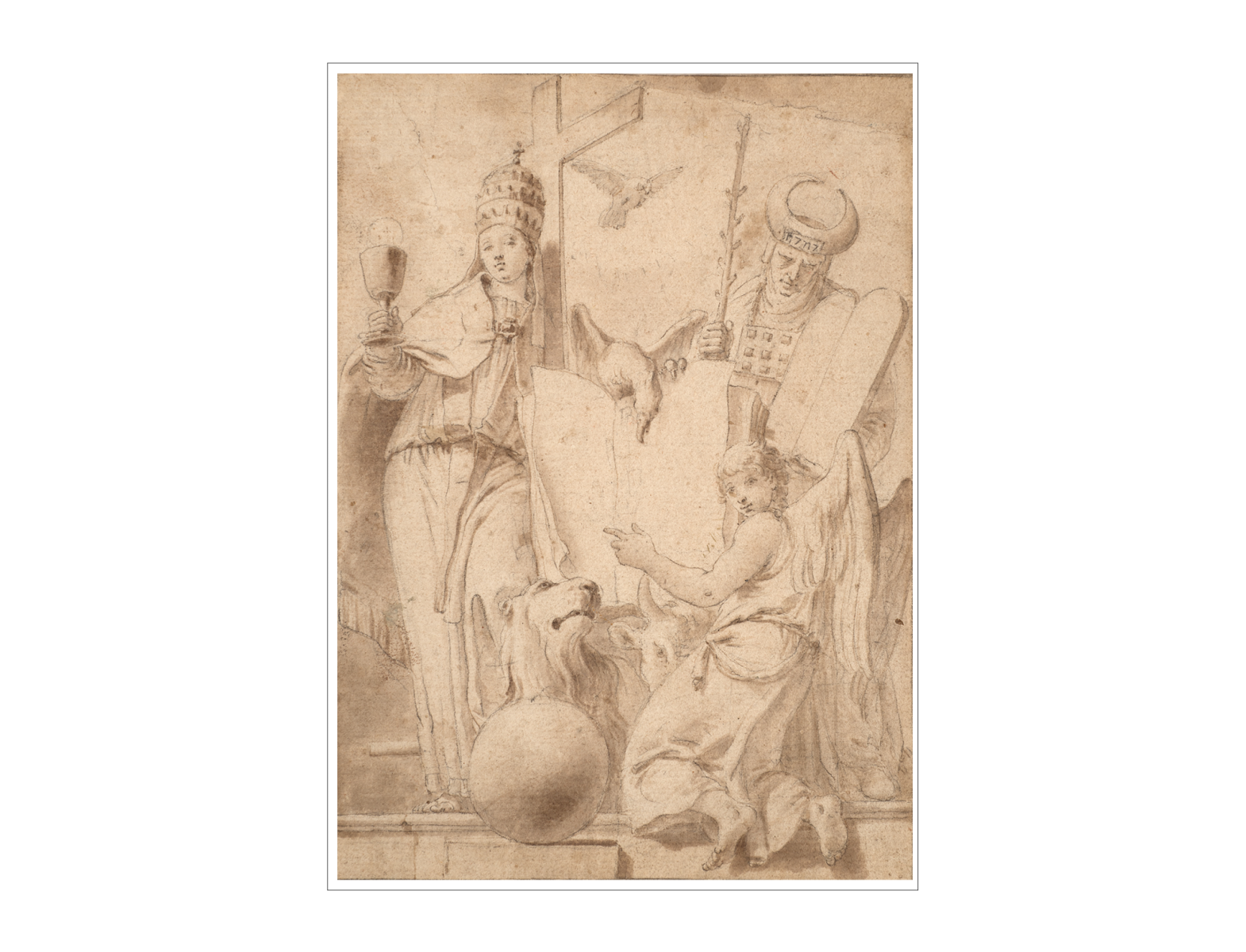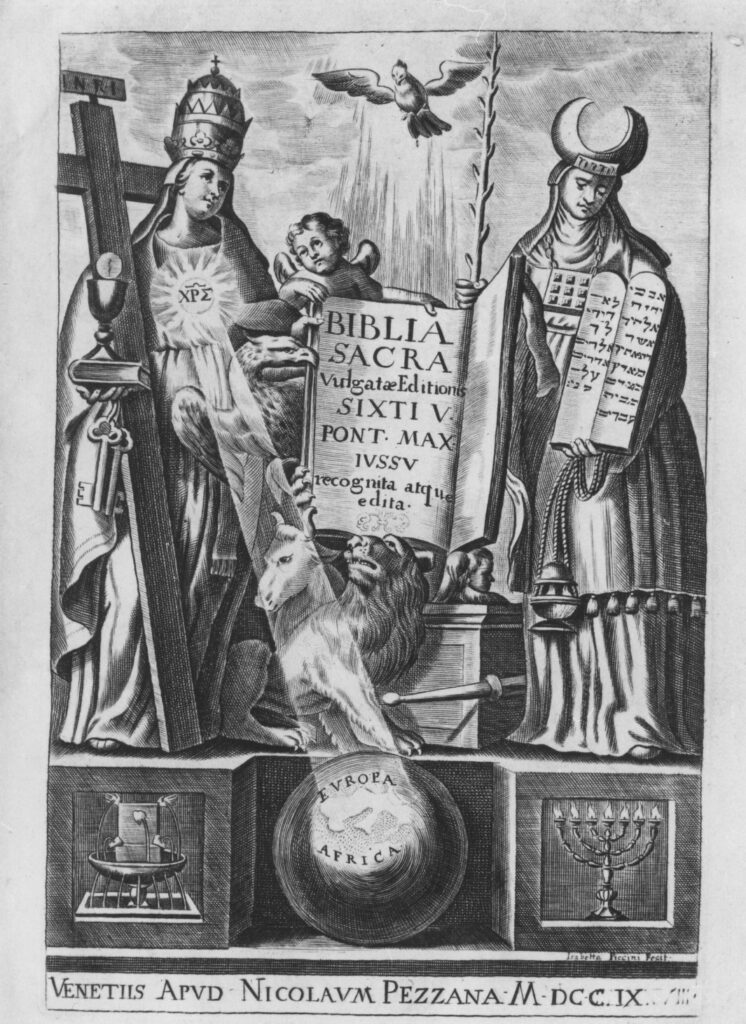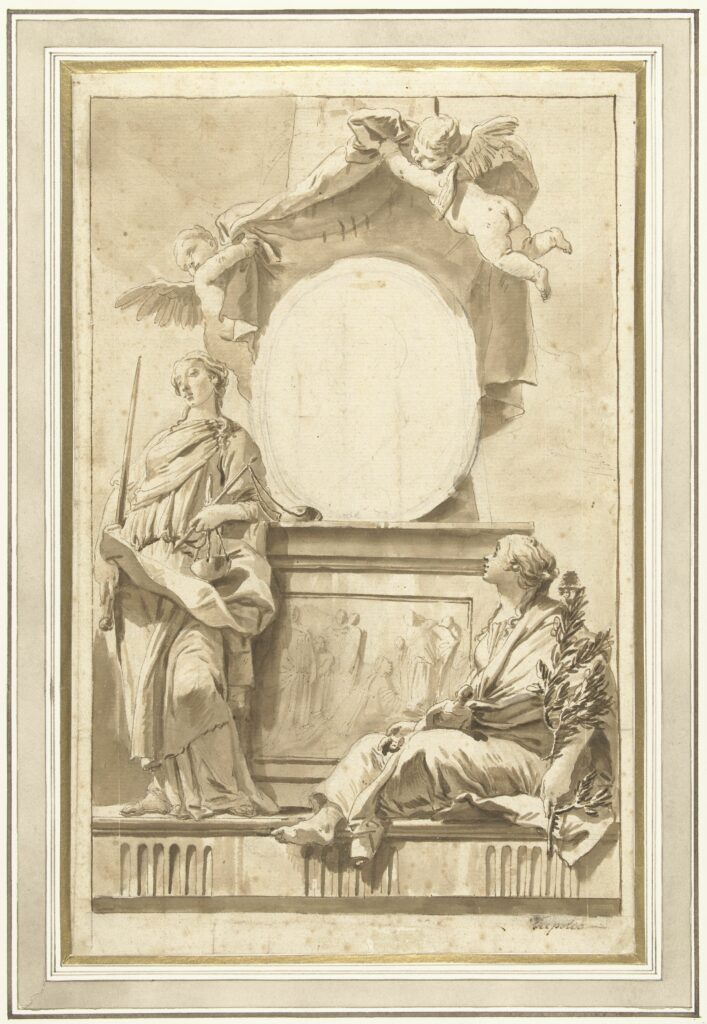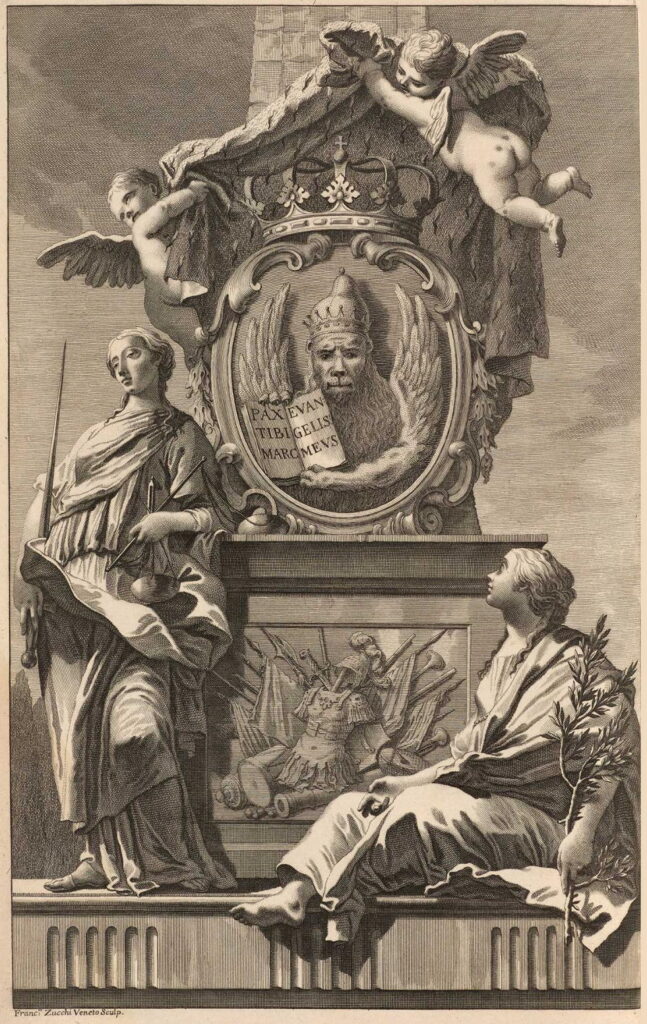Project for the Frontispiece of the Biblia Sacra by Cristoforo Zane by Giambattista Tiepolo

Giambattista Tiepolo
Venice, 1696 – Madrid, 1770
Project for the Frontispiece of the Biblia Sacra by Cristoforo Zane
Black chalk and brown ink wash.
210 x 145 mm – 8 1/4 x 5 11/16 in.
We are grateful to Bernard Aïkema for confirming the attribution to Giambattista Tiepolo after examination of the present drawing in the original and proposes to date it around 1727-1729.
Probably the most important Venetian painter of the 18th century, Giambattista Tiepolo is mostly famous for his paintings and frescoes in the palaces and churches of the Serenissima and its surroundings but he also devoted himself to the illustration of religious and historical books at the beginning of his career. At the request of publishers[1] he executed preparatory drawings which he then handed over to engravers, in particular to Andrea Zucchi (1679-1740) and his brother Francesco (1692-1764)[2]. The artist’s specialist, Bernard Aikema, reported the importance of Giambattista’s activity as an illustrator between 1720 and 1739 and established a list of his drawings in relation to engravings. Giambattista notably made drawings for the vignettes in presentation of historical texts for Rerum Italicarum Scriptores by Ludovico Antonio Muratori (25 volumes between 1723 and 1751)[3]. Most of the preparatory drawings, now in the Metropolitan Museum in New York, were executed in black chalk in a format respecting the final engravings, with the exception of the sheet kept in Amsterdam (Fig. 1) made in another technique – in pen and brown ink – for the Frontispiece of volume XII[4], Allegory of Peace and Justice paying homage to the lion of Saint Mark[5] (Fig. 2). This collaboration with the Zucchi brothers began at the beginning of the artist’s career and continued at least until 1741, when he participated with Francesco in the Missale Romanum edited by Poleti. The frontispiece of Saint Luke and the Allegory of Justice and Prudence[6] dates from 1730 for Divinus Paulus apostolus in mari, quod nunc Venetus sinus dicitur naufragus by Ignatio Georgio edited by Cristoforo Zane and, from 1740, the vignette for the frontispiece of Historia Congregationum de Auxiliis Divinae Gratiae by Jacques-Hyacinthe Serry[7].
Our sheet (fig. 3) is preparatory to a Frontispiece[8] (Fig. 4) illustrating the Biblia Sacra Vulgatae Editionis, Sixti V. Pontificis Max. Jussu Recognita, and Clementis VIII. Auctoritate edita published by Cristoforo Zane in 1730[9]. On the lower left margin of the print, the inscription Frco Zucchi S. indicates that the work was engraved by the artist Francesco Zucchi: the S. after his name meaning “sculpsit” for engraver, thus specifying that he was not the inventor of the motif. The subject evokes the allegories of the Roman Catholic Church and the Judaic Law. On the left, a young woman crowned with a papal diadem, the cross against her left shoulder and a chalice with the sacred Ostia in her right hand, symbolizes the New Religion (New Testament) while on the right, an old woman wearing a horn carrying the censer, the tablets of the divine precepts and the miraculous stick embodies Judaism (Old Testament). In the center, the open Bible is supported by the four evangelists and consecrated by the rays of light emanating from the dove of the Holy Spirit. In this pen and wash study, Giambattista traced the figures with a vibrant line, modeling their form and setting them with majestic gravity. He left certain elements in reserve – the open Bible, the terrestrial globe and the table of Laws – which were subsequently completed by Francesco Zucchi in the engraving. The keys of the Church and the chrism, in a sun on the chest of the New Testament, radiating its rays to the earth were also added in the final composition. To carry out his project, Giambattista Tiepolo was largely inspired by a frontispiece for the same work published in 1645 in Antwerp[10], then in Venice between 1669 and 1727[11]. Tiepolo must have owned a copy of the Biblia Sacra with the counterpart engraving of the Frontispiece (Fig. 5) executed by the Venetian engraver Sister Isabella Piccini [12] for the editions of Nicolaum Pezzana. Indeed, we find the same allegorical figures in almost identical positions. Tiepolo modified the framing, tightening the scene by replacing the pedestal with the symbolic objects of the two laws – the Fountain of life of the Christians and the candelabra with seven branches of the Hebrews – by a small platform. He relocated the emblems of the Evangelists: the eagle of Saint John resting its beak on the page of the open book and the Angel – symbol of the Evangelist Matthew – kneeling in the foreground pointing his finger towards the Roman church as to emphasize the message of the fulfillment of the law[13]. These changes confer a greater dynamism and bring a grandiose aspect to the composition.

[1] For example, Jacopo Vallarsi and Pierantonio Berno for the first edition of Verona illustrata by Scipione Maffei in 1732. [2] Denis Ton, “Bizzarrie di pensieri: Giambattista Tiepolo e la sua cerchia”, Tiepolo, Piazzetta, Novelli, l’incanto del libro illustrato nel Settecento Veneto, exhibition catalogue, Padua, Musei civivi agli Eremitano and Palazzo Zuckermann from November 24, 2012 to April 7, 2013, Treviso, Crocetta del Montello, 2012, p. 60-63. [3] The relations between the Zucchi brothers and Giambattista Tiepolo, brought into contact as early as 1724 by the writer Scipion Maffei, have been developed and highlighted by A. Middeldorf Kosegarten (cf. “Giambattista Tiepolos Entwürfe für Illustrations der Rerum italicarum scriptores ediert von Ludovico Antonio Muratori, Münchner Jahrbuch der bildenden Kunst, 58,2007, pp. 93-193.). [4] Francesco Zucchi after Giambattista Tiepolo, Allegory of Peace and Justice Paying Homage to the Lion of St. Mark, frontispiece of vol. XII of the work Rerum Italicarum Scriptores by Antonio Muratori (Milan, 1723-1751) preserved at Columbia University Libraries, New York. The Rerum Italicarum Scriptores is a compilation in twenty-five volumes of Italian historical sources, most of which date from the Middle Ages. Volume XII illustrated Venetian history. Tiepolo designed the frontispiece in which allegorical figures of Justice (with a sword and scales) and Peace (with a laurel branch) flank the lion of Saint Mark, symbol of Venice. [5] Pen, brown ink and brown wash over lines of black chalk; 33.5 x 21.4cm; Rijksmuseum, Amsterdam, inv. No. RP-T-1954-189. Bernard Aikema dates the sheet from 1724 from a stylistic point of view after relating it to the engraving by Francesco Zucchi (cf. Bernard Aikema, Tiepolo in Holland…, 1996, p. 14-15, cat 1). [6] Metropolitan Museum, New York, inv. 59.600.203. [7] A copy is kept at the Biblioteca Civica di Padova, inv. No. F4498. [8] In the lower margin appears the following inscription: Venetiis apud Christophorum Zane MDCCXXX and the signature F.co Zucchi. A copy is kept at the University Library of Padua, inv. No. 78.b.85. Cf. Tiepolo, Piazzetta, Novelli, l’incanto del libro illustrato nel Settecento Veneto, exhibition catalogue, Padua, Musei civivi agli Eremitano and Palazzo Zuckermann from November 24, 2012 to April 7, 2013, Treviso, Crocetta del Montello, 2012, p . 76-77, no. I.4, repr. [9] Biblia Sacra Vulgatae Editionis, Sixti V. Pontificis Max. Jussu Recognita, and Clementis VIII. Authoritate edita; … Nec non Prolegomenis necessarioribus illustrata– .., Venetiis – apud Christophorum Zane, 1730, 2 vols. [10] According to our research, the first copy of this engraving that we found was published in Antwerp by the Officina Plantiniana in 1645. [11] Pietro Zani lists several editions of the Biblia Sacra illustrated by Sister Isabella Piccini: in 1669, 1690, 1723 and 1727 (Cf. Enciclopedia metodica critico-ragionata delle belle arti dell’abate D. Pietro Zani Fidentino, Parte seconda, vol. II, Parma, 1819, pp. 59-62). We have chosen to bring the engraving closer to the 1709 edition because it is presented in the same direction as the drawing by Giambattista Tiepolo. [12] Daughter of the Venetian engraver Giacomo Piccini, Elisabetta (1644-1734) trained in the art of drawing and engraving from the great masters. In 1666, she entered the convent of Santa Croce in Venice and took the name Suor Isabella. She continued to work signing Suor Isabella Puccini as an engraver accepting numerous orders from Venetian publishers to illustrate liturgical books, biographies of saints and prayer manuals. [13] Cf. Gospel of Saint Matthew (5, 17: Do not think that I (Jesus) came to abolish the Law or the Prophets: I did not come to abolish but to fulfill”. [14] Francesco Zugno helped his master to carry out several projects of book illustration. [15] Black chalk, brown wash heightened with white gouache; 39.2 x 25.9cm; Princeton University Art Museum, Inv. No. x1948-770. Knox proposes a dating of this project between 1625 and 1632 (cf. George Knox, “A group of Tiepolo Drawings Owned and Engraved by Pietro Monaco”, Master Drawings, III, 1965, n° 4, p. 392, pl. 30) . [16] The drawing is kept at the Biblioteca Palatina in Parma.



